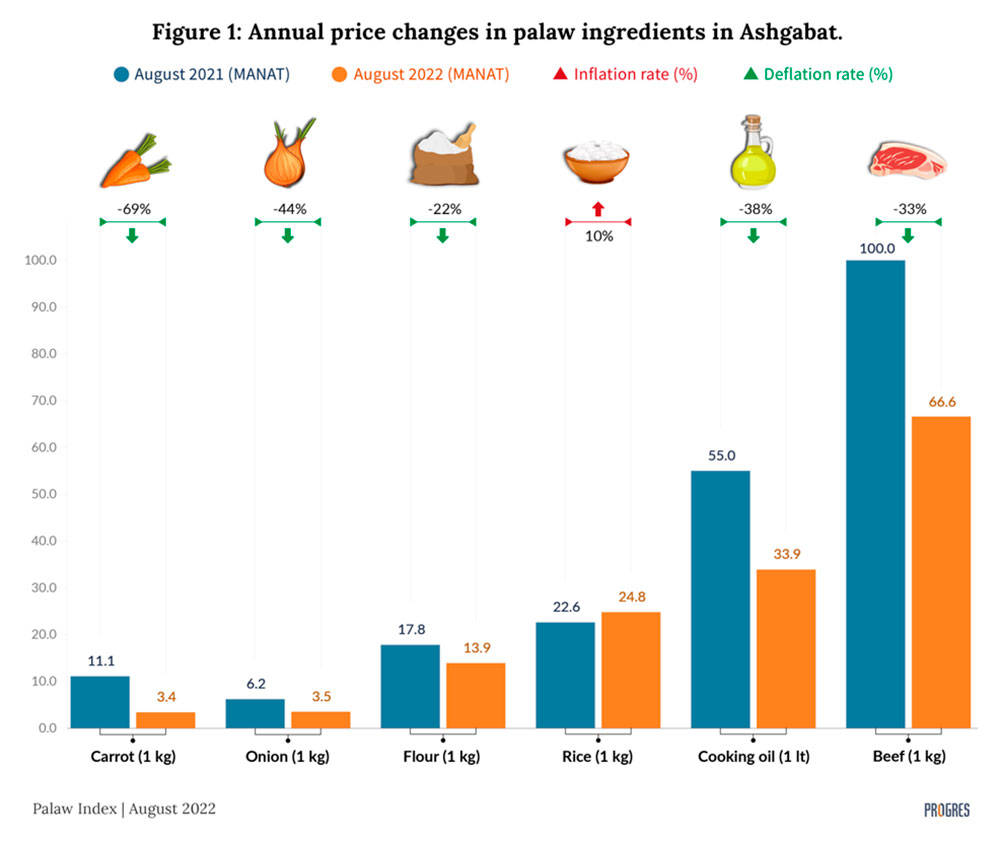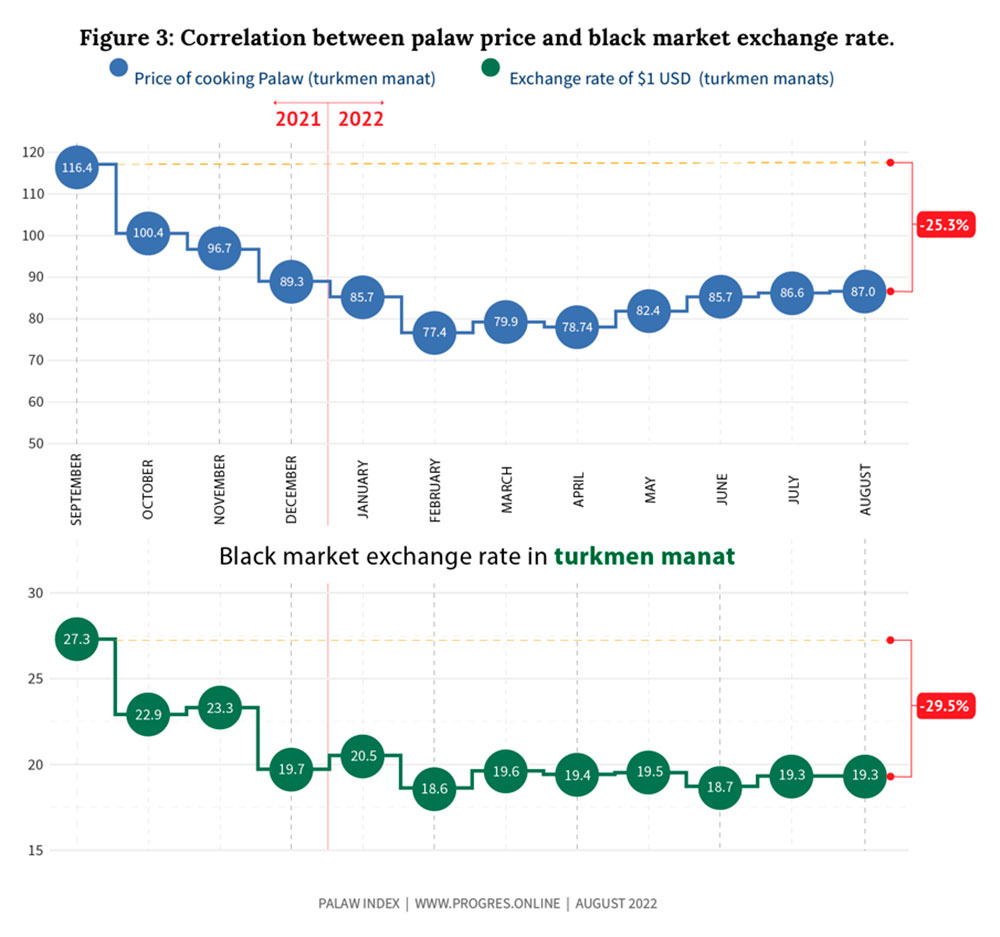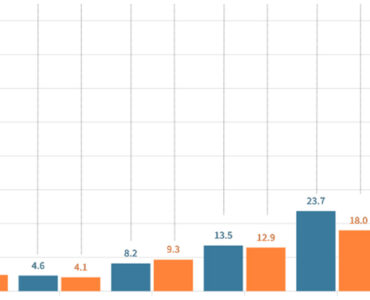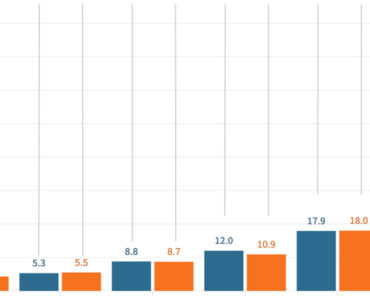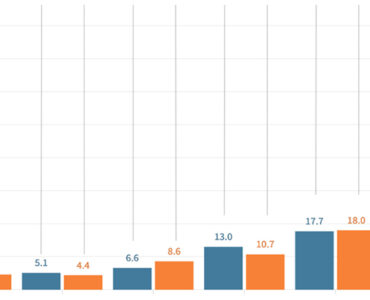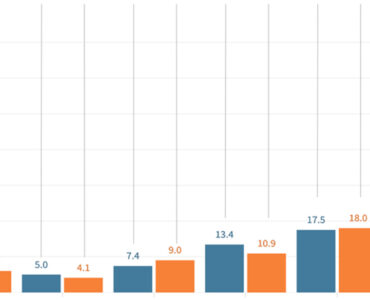August 2022: The cost of palaw drops for the third month in a row
The average cost of cooking palaw in Ashgabat was 87 Turkmen manat in August 2022, which is 0.4% more expensive month-on-month (MoM) compared to the prices observed last month (86.6 manat) and 28.8% cheaper year-on-year (YoY) compared to the prices in the corresponding month of the last year in August 2021 (122.2 manat). This is the third time in a row, when palaw prices decline based on YoY after dropping by 13.4% and 9.1% in June and July 2022.
Similar to the trends of the last two months, prices of all palaw ingredients except for rice have fallen in August 2022 on a YoY basis: carrots (-69%), onions (-44%), sunflower oil (-38%), beef (-33%), and wheat flour fell (-22%) compared to similar month in 2021. Prices for rice, on the other hand, have risen by 10% over the same period of time (see Figure 1).
Why did the price of rice increase?
As you may see on Figure 1, prices of all palaw ingredients have declined except for rice in Ashgabat the third time in a row. Other palaw ingredients saw a significant price decline in August 2022 mainly due to a cheaper USD exchange rate, which decreased from 32.4 manat last August to 19.3 manat this August 2022, which is a 40.4% decline. We have collected prices for riсe (brand Elenga) sold in Turkmenistan from January 2020 to this day and we compiled all these numbers in a single chart (see Figure 2).
As we can see from this chart, the rice in 2022 is a lot more expensive compared to the prices in the previous two years. On a monthly basis, rice prices were more expensive in every single month of 2022 above their corresponding value over the last two years except for April.
So, what makes rice prices an exception to this continuous trend? We have listed possible reasons for price hikes of rice sold in Turkmenistan in recent months.
Water shortages
There is a Turkmen saying that “Şaly suwsuz bolmaz, palaw – bugsuz” (in English: “Rice cannot survive without water, palaw cannot be cooked without steam”). Domestically, rice is grown in Lebap and Dashoguz regions since rice cultivation requires large amounts of water, and these two regions are located along the Amyderya river, which helps farmers with the irrigation of rice. The main brands of rice grown in the country are Elenga, Nukus-2 and Müňbaşy. For agricultural irrigation, in general, water of the Amyderya river and Garagum canal are used. In recent months, water shortages have become quite common for both agricultural and civilian use (Hronikatm, Turkmennews, Azatlyk).
In August 2022, Hronika reported that former government officials have direct access to abundant water while other farmers struggle with water shortages. Moreover, ex-officials are allowed to grow in the fields not cotton and wheat, which are obligatory for other farmers, but more profitable barley and rice. Since the government owns the land in the country, it leases land to farmers with conditions that a minimum of 70% of the land should be cultivated for wheat, cotton, and other state-mandated crops.
FAO reports that water is the single most important component for sustainable rice production. Among the crops of palaw ingredients, rice has the highest water footprint during its production cycles requiring 2500 liters of water to produce 1kg of mulled rice. The water footprint of other crops from the Palaw Index is: 1849 liters of water per 1kg of wheat flour, 272 liters of water per 1kg of onion, and 195 liters of water per 1kg of producing carrots (Water Footprint Network 2022).
Donate to support Turkmen analysts, researchers and writers to produce factual, constructive and progressive content in their efforts to educate the public of Turkmenistan.
SUPPORT OUR WORKWater from the Caspian Sea is salinized (11-12.8 grams of salt per liter) and it can be used for neither agricultural irrigation nor for civilian purposes. Therefore, reduced water supplies can have a direct impact on agricultural output.
Water-related problems are even admitted by the government and the issue has been raised several times throughout this year. In June 2022, Serdar Berdimuhamedov instructed state officials to consider the possibility of starting the construction of desalination plants and supplying water to Ashgabat from the Caspian Sea. In another meeting in the same month, he instructed the officials to use water rationally and ordered them to maintain water facilities “in proper operational condition” and to analyze them. Since June 2022, many districts in Ashgabat face frequent water cut-offs in the mornings and evenings. This problem has been prevalent even earlier in other regions of the country and in some cases, households can be left without running water the whole day.
Given the fact that growing rice requires a lot more water than other crops, we can assume that it contributed to reduction in rice production in 2022, which further led its price to increase. The government of Turkmenistan sometimes shares the total annual production of rice in the country. The harvested rice reached 82,400 tons in 2021, which is similar to the numbers in 2020. Similar goals have been put in place for the year 2022. However, statistics on annual rice production might not be reliable given the poor reputation of the government agencies in providing statistics and data. For instance, Hronika claimed that the real harvested amount of wheat in the country was 3 times lower in 2018 and 2 times lower in 2019 compared to the officially reported numbers. The World Bank stopped publishing economic data on Turkmenistan in its publications in 2020 due to “the lack of reliable data of adequate quality”.
Reduced volume of imported rice
A large share of consumed rice in Turkmenistan is domestically grown and only a small fraction is imported from abroad. Foreign suppliers of rice to the country are India, Pakistan, and Russia. Turkmenistan imports very little from the Eurasian Economic Union countries (Russia, Kazakhstan, Kyrgyzstan, Belarus, and Armenia) and it amounted to only 15 tonnes with a value of 14289 USD with Russia being the only supplier from this Union. The share of India’s rice exports to Turkmenistan is higher and amounted to 421,000 USD in 2020.
According to the FAO’s Rice Price Index, international rice prices have gone up by 10.9% in August 2022 YoY compared to a similar period last year. Therefore, price increases of rice in international markets might have contributed to the growing price of rice sold in Turkmenistan. However, since the share of rice is so low, that price changes in imported rice will not have a significant impact on domestic prices.
What about monthly price changes of palaw?
On a monthly basis, prices of palaw ingredients have been decreasing steadily over the last year from 116.4 manat in September 2021 to 87 manat in August 2022, which is a 25.3% decline. When it comes to the black-market exchange rate of the manat/USD, it declined from 27.3 manat in September 2021 to 19.3 manat in August 2022, which is a 29.5% decrease (see Figure 3).
Methodology
Prices of ingredients in the Palaw Index are collected for 1 kg of onion, carrot, beef, rice, and flour, and 1 liter of cooking oil. Based on the methodology, in order to cook palaw for a family of four, we use 0.3 liters of cooking oil, 0.5 kg of onion, 1 kg of carrots, 0.6 kg of beef, 1 kg of rice, and 0.5 kg of flour in our formula. Please click here to learn more about the methodology of the Palaw Index.


